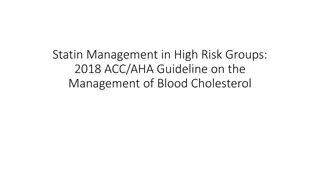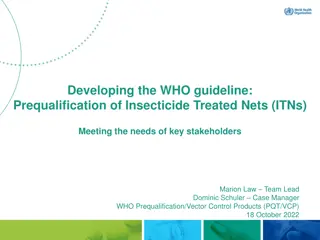
Understanding the Importance of Energy Information Systems in Municipal Energy Management
Explore the significance of Energy Information Systems in Municipal Energy Management, essential for identifying savings opportunities, minimizing energy waste, and making informed decisions. Learn about the implementation of energy management interventions and the use of the PDCA cycle for continuous improvement.
Download Presentation

Please find below an Image/Link to download the presentation.
The content on the website is provided AS IS for your information and personal use only. It may not be sold, licensed, or shared on other websites without obtaining consent from the author. If you encounter any issues during the download, it is possible that the publisher has removed the file from their server.
You are allowed to download the files provided on this website for personal or commercial use, subject to the condition that they are used lawfully. All files are the property of their respective owners.
The content on the website is provided AS IS for your information and personal use only. It may not be sold, licensed, or shared on other websites without obtaining consent from the author.
E N D
Presentation Transcript
1 GUIDELINE 4: ENERGY INFORMATION SYSTEMS 1
2 GUIDELINE 4: ENERGY INFORMATION SYSTEMS Welcome and thank you for taking the time to read this guideline. This guideline is the 4th in a series of 15 guidelines on different components of a Municipal Energy Management System. This guideline is focused on the establishment of the Energy Information Systems that are required to assist with identifying potential energy- and cost-saving opportunities, and to track the impact of any energy conservation measures. This module covers the following areas: Municipal Energy Management Systems Programme Guideline Series The importance of energy information systems How to organise energy information systems
MUNICIPAL ENERGY MANAGEMENT SYSTEMS Policy Investment Organisation Energy Management Systems have many components. For this guideline we will be focussing on the information systems component Implementation Marketing and Communication Skills and Knowledge Information Systems Municipal Energy Management Systems Programme Guideline Series
4 USING THE PLAN-DO- CHECK-ACT CYCLE ISO 50001, the international standard for Energy Management Systems, adopts the Plan-Do-Check-Act Cycle to ensure the continuous improvement of energy management systems. Check Act The PDCA (Plan-Do-Check-Act) Cycle is an iterative four-step management method that is used in many contexts to achieve the continuous improvement of processes. Do Plan Municipal Energy Management Systems Programme Guideline Series 4
5 IMPLEMENTATION OF ENERGY MANAGEMENT INTERVENTIONS ARE AN ITERATIVE PROCESS Check Do Act Check Plan Do Act Check Plan Do Act Municipal Energy Management Systems Programme Guideline Series Plan 5
6 WHY ARE ENERGY INFORMATION SYSTEMS IMPORTANT? GUIDELINE 4: ENERGY INFORMATION SYSTEMS Municipal Energy Management Systems Programme Guideline Series
7 TO MEASURE IS TO KNOW Identifying Opportunities Without energy information, it is difficult to identify new savings opportunities Identifying Risks Without energy information, large amounts of energy waste can go unnoticed Allows for Decisions Without energy information, decisions are made on instinct rather than fact Municipal Energy Management Systems Programme Guideline Series
8 INFORMATION SYSTEMS ALSO TRACK THE IMPACT OF DECISIONS The Monitor ongoing operations and implementation Verify and track progress towards targets identification of new energy management interventions Municipal Energy Management Systems Programme Guideline Series
9 HOW DO YOU SET UP ENERGY INFORMATION SYSTEMS? GUIDELINE 4: ENERGY INFORMATION SYSTEMS Municipal Energy Management Systems Programme Guideline Series
10 SETTING UP AN ENERGY INFORMATION SYSTEM Step 1: Understand your different data types Step 2: Set up your data in rows and columns Step 3: Clean your data Step 4: Summarise your data Step 5: Update and review your data Municipal Energy Management Systems Programme Guideline Series
11 STEP 1: UNDERSTAND YOUR DIFFERENT DATA TYPES Date (Year, Month, Day) Time (hour, minute) Account Number Account Name Consumption (kWh) Amount (ZAR) Data Type refers to the kind of data being stored Municipal Energy Management Systems Programme Guideline Series
12 STEP 2: SET UP YOUR DATA IN ROWS AND COLUMNS Row Municipal Energy Management Systems Programme Guideline Series
13 STEP 2: SET UP YOUR DATA IN ROWS AND COLUMNS Expert Advice ACCT_ID PREM_ID ADDRESS 3324229365 442422954210 MTHEMBU STREET Columns should only contain a single data type 3371124540 447112490812 SECOND STREET 3385076851 448507620914 THIRD STREET 3353854477 445385440628 FOURTH STREET- LIBRARY 3347171166 44471711615 GREEN STREET- MUSEUM 3322487717 442248716662 JAMES CRESCENT 3311203575 441120306239 FIRST STREET 3343220747 4483408784WARD 10 HIGHMAST LIGHTS Municipal Energy Management Systems Programme Guideline Series 3368374824 4431433238CCTV CAMERAS
14 STEP 2: SET UP YOUR DATA IN ROWS AND COLUMNS ACCT_ID PREM_ID ADDRESS Expert Advice 3324229365 442422954210 MTHEMBU STREET 3371124540 447112490812 SECOND STREET A row is a horizontal grouping of cells The content is unique to that row (e.g., a point of supply) 3385076851 448507620914 THIRD STREET 3353854477 445385440628 FOURTH STREET- LIBRARY 3347171166 44471711615 GREEN STREET- MUSEUM 3322487717 442248716662 JAMES CRESCENT 3311203575 441120306239 FIRST STREET 3343220747 4483408784WARD 10 HIGHMAST LIGHTS 3368374824 4431433238CCTV CAMERAS 3326302933 4450713128HOPEVILLE & LOMANYANENG HIGHMAST LIGHTS HOPEVILLE SEWERAGE, STAND12 BOUNDARY STREET, HOPEVILLE Municipal Energy Management Systems Programme Guideline Series 3382157412 4482157432 3392876881 4424772114HOPEVILLE HIGH MAST LIGHT NO 3
15 STEP 3: CLEAN YOUR DATA Common Mistakes in Data Organisation Putting the same data type in multiple columns Having multiple tabs for the same type of data Inconsistencies in account names Municipal Energy Management Systems Programme Guideline Series
16 STEP 3: CLEAN YOUR DATA ACCOUNT NAMES Rule One: Ensure that the names of accounts are consistent throughout your energy information system Computers can t tell that names with slight differences refer to the same thing In energy information, it is common for specific accounts to have more than one name. The municipal staff dealing with the accounts know that these different names refer to the same account, but a computer would treat these as two separate accounts A computer even treats the same name with a small spelling mistake as a different account Municipal Energy Management Systems Programme Guideline Series
17 STEP 3: CLEAN YOUR DATA DATA TYPES Common Mistakes 2 Putting the same Data Type in different columns January kWH Consumption February kWH Consumption March kWH Consumption April kWH Consumption ACCT_ID 3324229365 3371124540 3385076851 3353854477 3347171166 13683 1256 45532 235 12121 14686 1357 45438 339 12223 13781 1852 45933 234 12325 14685 1356 45437 338 12229 Municipal Energy Management Systems Programme Guideline Series
18 STEP 3: CLEAN YOUR DATA DATA TYPES Rule Two: Avoid multiple columns with the same data type The computer can t see the connection between the columns Before analysing the data, columns with the same data types will have to be combined into a single column Municipal Energy Management Systems Programme Guideline Series
19 STEP 3: CLEAN YOU YOUR DATA DATA FILE STRUCTURE January kWH Consumption February kWH Consumption March kWH Consumption April kWH Consumption ACCT_ID 3324229365 13683 14686 13781 14685 January kWH Consumption 3385076851 February kWH Consumption March kWH Consumption April kWH Consumption 3371124540 1256 1357 1852 1356 ACCT_ID 45532 45438 45933 45437 3324229365 13683 14686 235 13781 339 14685 234 3353854477 338 3371124540 1256 1357 1852 1356 January kWH Consumption 3385076851 February kWH Consumption 45532 3322487717 March kWH Consumption April kWH Consumption Common Mistakes 3 Putting the same databases in different tabs 3347171166 12121 12223 12325 12229 ACCT_ID 45438 5347 45933 5144 45437 5446 5540 3324229365 13683 14686 235 13781 339 14685 6275 3353854477 234 338 3311203575 6376 6577 6971 3371124540 1256 Tab 1: 2017/2018 Financial Year 1357 1852 12223 1356 12325 3347171166 12121 12229 179698 3343220747 179797 178798 179692 3385076851 45532 45438 5347 45933 5144 45437 5446 343886 3322487717 5540 3368374824 346888 346789 356083 3353854477 235 339 234 338 6577 3311203575 Tab 2: 2018/2019 Financial Year 6376 6275 6971 3347171166 12121 12223 12325 178798 12229 179698 3343220747 179797 179692 3322487717 5347 5144 5446 5540 346789 3368374824 346888 343886 356083 3311203575 Tab 3: 2019/2020 Financial Year 6376 6275 6577 6971 3343220747 179797 178798 179698 179692 Municipal Energy Management Systems Programme Guideline Series 3368374824 346888 343886 346789 356083
20 STEP 3: CLEAN YOU YOUR DATA DATA FILE STRUCTURE Rule Three: Avoid multiple tabs with the same database type Computers can t connect data from one tab to data on other tabs It is easy for inconsistencies in account names to creep in between the tabs Before analysing the data, the tabs will have to be combined Municipal Energy Management Systems Programme Guideline Series
21 STEP 4: SUMMARISE YOUR DATA Combine databases with the same information (e.g., Eskom and Municipal Accounts) by matching columns Create a new summary database with only the columns you need Expert Advice Avoid copying and pasting the data. Rather reference ( use = ) your original data source Date (Year, Month, Day) Time (hour, minute) Account Number Account Name Consumption (kWh) Municipal Energy Management Systems Programme Guideline Series Amount (ZAR)
22 STEP 4: SUMMARISE YOUR DATA COMBINE DATA SETS Municipal Accounts Eskom Accounts Acc Number Meter No Address Reading date kWh ACCT_ID MTR_ID ADDRESS DATE KWH 3324229365 13683282-2902 Aliquam Rd. 01-Jan-22 9109841103 100958572505 Vitae Rd. 19-Jan-22 272 821 3371124540 12565275 Vulputate, Av. 17-Jan-22 2205359862 10065821494-3203 Hendrerit St. 13-Jan-22 859 381 3385076851 45532766-8551 Odio. St. 15-Jan-22 9289496614 100696658064 Sed Av. 04-Jan-22 4 791 3353854477 2351052 Convallis St. 17-Jan-22 1993654605 10048099828-2764 Aliquet, Ave 09-Jan-22 525 714 Acc Number Meter No Address Reading date kWh Type Combined database 3324229365 13683282-2902 Aliquam Rd. 01-Jan-22 272 Municipal 9109841103 100958572505 Vitae Rd. 19-Jan-22 821 Eskom Municipal Energy Management Systems Programme Guideline Series 3371124540 12565275 Vulputate, Av. 17-Jan-22 859 Municipal 2205359862 10065821494-3203 Hendrerit St. 13-Jan-22 381 Eskom
23 STEP 4: SUMMARISE YOUR DATA COMBINE DATA SETS Download from cloud with solid fill Create filters on your data Acc Number Meter No Address Reading date kWh Type 3324229365 13683282-2902 Aliquam Rd. 01-Jan-22 272 Municipal 9109841103 100958572505 Vitae Rd. 19-Jan-22 821 Eskom 3371124540 12565275 Vulputate, Av. 17-Jan-22 859 Municipal Download data consolidation tool 2205359862 10065821494-3203 Hendrerit St. 13-Jan-22 381 Eskom Create graphs from your data 90,000,000 Community Services 80,000,000 Facilities 70,000,000 Public Lighting 60,000,000 Water and Sanitation 50,000,000 Other 40,000,000 Municipal Energy Management Systems Programme Guideline Series 30,000,000 20,000,000 10,000,000 0 2015 2016 2017 2018 2019 2020
24 STEP 5: UPDATE AND REVIEW YOUR DATA Expert Advice Once your database is in place, its important to regularly update the data (aim for updates at least once a month) New accounts are always appearing in the data. Make sure you review your accounts database regularly. But, new data can introduce errors Every time you add new data check your summary tables to make sure there are no errors If errors occur, find out why and clean the data Municipal Energy Management Systems Programme Guideline Series
25 SEE OTHER GUIDELINES Municipal Energy Management Systems Programme Guideline Series
26 CLICK ON THE BLOCKS BELOW TO SEE OTHER GUIDELINES IN THE SERIES 1 8 9 Developing a municipal energy policy Developing a municipal energy policy Developing a municipal energy policy Developing an Energy Intervention Concept Note Developing an Energy Intervention Concept Note Energy Management Procurement Considerations Energy Management Procurement Considerations Developing a municipal energy policy Developing an Energy Intervention Concept Note Energy Management Procurement Considerations Developing a municipal energy policy Developing an Energy Intervention Concept Note Energy Management Procurement Considerations Establishing an energy management committee 2 7 10 15 Municipal Energy Management Matrix and Initial Assessment Municipal Energy Management Matrix and Initial Assessment Establishing an energy management committee Establishing an energy management committee Implementing energy conservation interventions Implementing energy conservation interventions Energy Management Action Plan Development Energy Management Action Plan Development Municipal Energy Management Matrix and Initial Assessment Establishing an energy management committee Implementing energy conservation interventions Energy Management Action Plan Development Municipal Energy Management Matrix and Initial Assessment Establishing an energy management committee Implementing energy conservation interventions Energy Management Action Plan Development Municipal Energy Management Matrix and Initial Assessment 6 3 14 11 Energy Management in Water and Sanitation Silulumanzi Lessons Energy Management in Water and Sanitation Silulumanzi Lessons Ensuring appropriate energy management skills knowledge Ensuring appropriate energy management skills & knowledge Prioritising Energy Management Interventions Prioritising Energy Management Interventions Investing in energy conservation Investing in energy conservation Energy Management in Water and Sanitation Silulumanzi Lessons Ensuring appropriate energy management skills knowledge Prioritising Energy Management Interventions Investing in energy conservation Energy Management in Water and Sanitation Silulumanzi Lessons Ensuring appropriate energy management skills knowledge Prioritising Energy Management Interventions Energy Management in Water and Sanitation Silulumanzi Lessons 4 Marketing and communicating energy-related information 5 12 13 Municipal Energy Management Systems Programme Guideline Series Marketing and communicating energy-related information Marketing and communicating energy-related information Checking the Success of an Implemented Energy Intervention Checking the Success of an Implemented Energy Intervention Establishing energy information systems Establishing energy information systems The Role of Energy Audits The Role of Energy Audits Marketing and communicating energy-related information Checking the Success of an Implemented Energy Intervention Establishing energy information systems Marketing and communicating energy-related information The Role of Energy Audits Checking the Success of an Implemented Energy Intervention Marketing and communicating energy-related information Checking the Success of an Implemented Energy Intervention






















